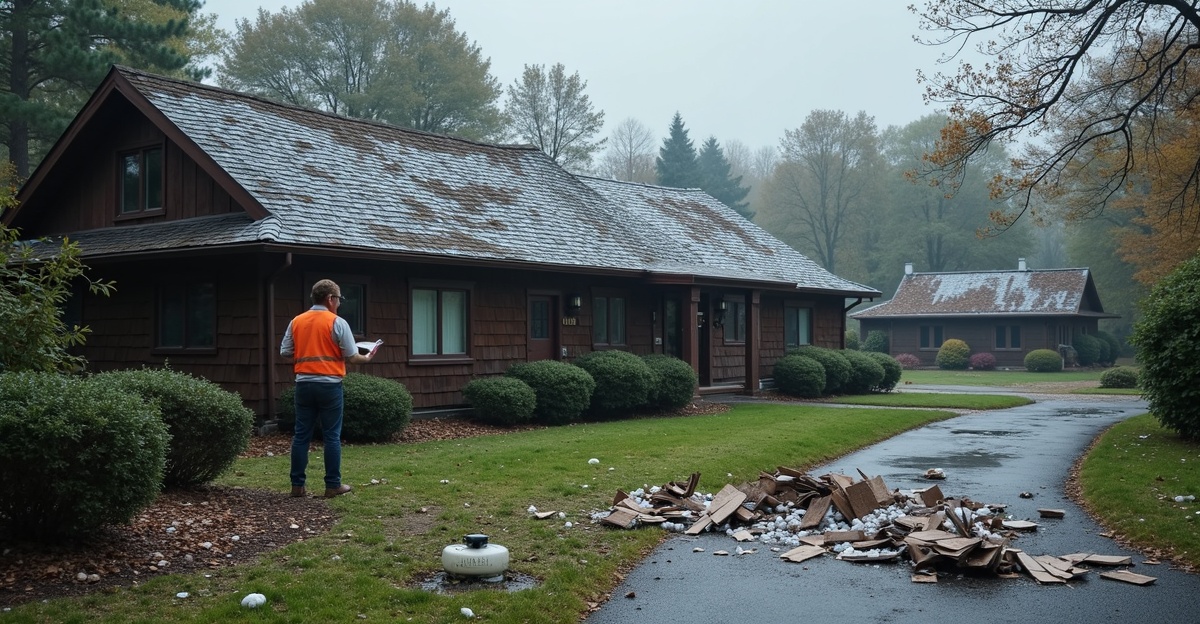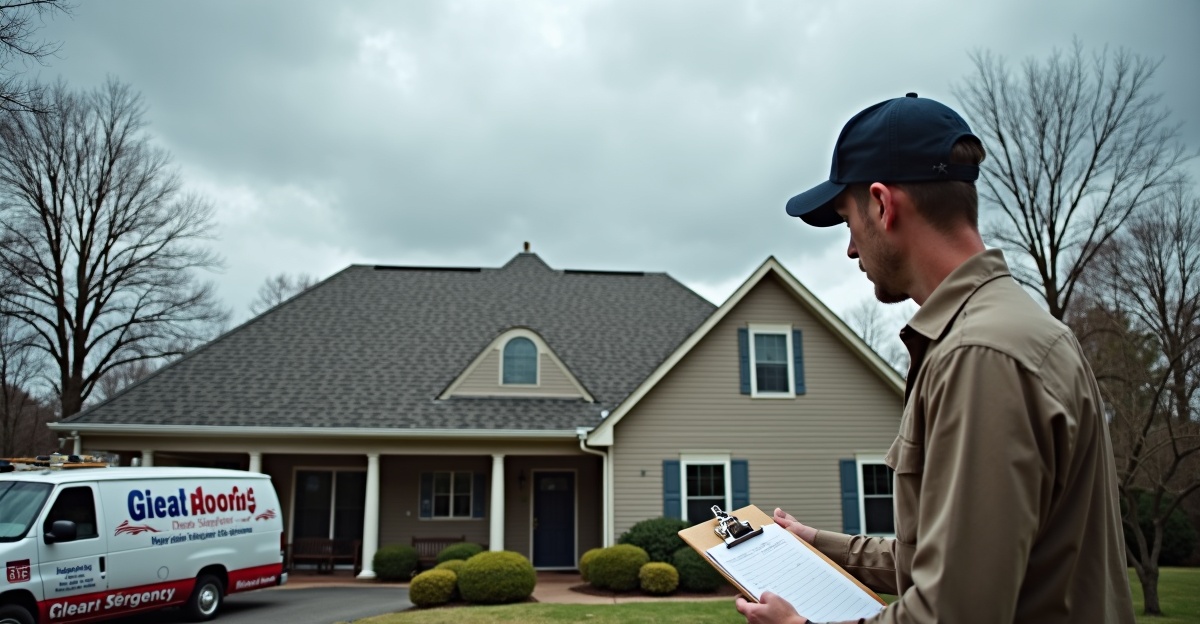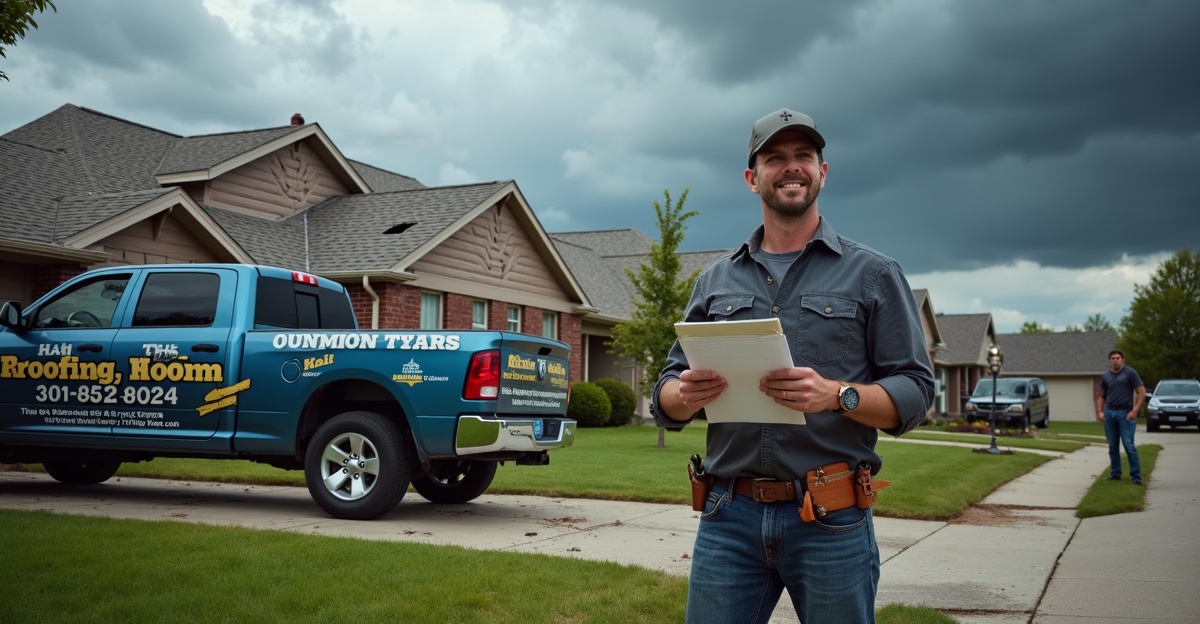What to Do After a Hail Storm Damages Roof

After a storm, hail damage to your roof can go unnoticed—but acting quickly keeps minor issues from turning into major repairs. From unseen punctures to strict insurance timeframes, taking the right steps after a hailstorm protects your home, budget, and peace of mind.
Key Takeaways
- Avoid climbing on the roof—walk around the house to check for dents, scattered debris, or loose shingles from the ground.
- Take clear, time-stamped photos of any visible damage before contacting your insurance provider or a contractor.
- Book a professional roof inspection as soon as possible to spot hidden issues and stay within insurance timelines.
- Submit your insurance claim early, and work with a contractor during the process to help ensure quicker approvals and stronger coverage.
- Hire a trusted, proven local roofer with storm repair knowledge and a reputation for reliable service.

Check for Damage Safely—and Don’t Trust the Naked Eye
Safety comes first. If your roof’s taken a hit from hail, don’t climb up there yourself—not even for a quick peek. It might look fine from below, but there’s a real risk of slipping on loose granules or stepping on unseen weak spots. Broken shingles or structural shifts make it unsafe for anyone without the right gear and training.
Instead, walk the perimeter of your home or building. You can spot several surface-level issues without getting on the roof:
- Dents or dimples in gutters, downspouts, and metal flashing
- Shingles with visible bruising or missing granules
- Asphalt debris around the foundation
- Displaced roofing material near roof edges or vents
Flat commercial roofs need a closer look at water drainage. If you see standing water that wasn’t there before, or unusual bubbles in the membrane, that’s a red flag. Hail can slice through synthetic materials, and left unchecked, the damage compounds quickly.
Why Hidden Damage Matters
The toughest part? Much of the worst damage won’t be visible to the naked eye. Shingles might look fine but have fractured fiberglass mats underneath. A punctured underlayment or a hairline tear in a membrane can cause slow leaks that take months to surface—by then the damage has spread. These invisible roof damage signs lead to:
- Interior leaks
- Mold behind walls
- Weak spots in attic framing
- Voided manufacturer warranties
We’ve seen cases where homeowners waited too long, and the fix went from a minor roof repair to a full tear-off. Catching it early is the only way to keep costs down and avoid bigger headaches.
Get Professional Eyes on It
You’re not expected to know what cracked matting or fractured flashing looks like. That’s where we come in. A certified inspection doesn’t just catch problems—it also helps you document them for insurance. Hidden damage can lead to claim delays or denial if you wait too long.
If you’re not sure what to do first, follow our step-by-step guide to filing a roof insurance claim. It walks through how to record hail damage and what your insurer will ask for.
For homes and businesses alike, time is critical. Whether it’s pooling water on a flat membrane or quiet bruising on asphalt shingles, hail doesn’t leave behind gentle reminders. It causes real damage—and fast. If you’re seeing warning signs or just not sure, our storm damage repair team can handle the inspection and make sure nothing slips through the cracks.

Document Everything Before You Call Anyone
Start with Clear Visual Proof
Take a slow walk around your property as soon as it’s safe after a hailstorm. Don’t rush this step. Use your smartphone or camera to capture time- and date-stamped photos and videos of anything the storm touched. These images tell the story your insurance company needs to see.
Here’s what to focus on documenting:
- Roofing materials—look closely at shingles, tiles, or metal panels
- Skylights, vents, and flashing
- Gutters and downspouts
- Exterior siding and windows
- Patios, decks, fences, and landscaping
- Vehicles parked on the property
- Items on the ground like dislodged shingles or broken flashing
Gathering this evidence helps with more than just insurance—it builds a record you can refer back to later. If a claim gets challenged, these files could make the difference between getting compensated or getting denied. As our RayPro team likes to say, “Good documentation often shortens the insurance process and strengthens your case from day one.”
Commercial property managers should also capture wide-angle images of entire roof systems, external HVAC units, and high-traffic or customer-facing areas. These shots provide adjusters with important context they can’t get standing on the ground.
Care for What the Storm Left Behind
Keep anything the hail knocked loose. That means shingles, flashing, vents, or debris that came from the roof. Pile it somewhere out of the way, but don’t toss it. An adjuster or contractor may need to see it during the inspection. What looks like junk may actually help prove the force and direction of the impact.
While inspecting for damage, we recommend using a simple checklist that covers both roofing and property features. If you’re not sure where to start, our team put together an easy resource: the ultimate roof inspection checklist makes sure you don’t miss what matters. Whether it’s your home or a commercial property, it helps keep the facts organized during what’s often a stressful time.
Also, watch for common signs of hail damage on roof materials—like bruised shingles, dented vents, or cracked tiles. Some of this damage can seem cosmetic at first but turn into bigger problems later. Knowing how to spot these issues early puts you in a stronger position to act fast, protect the structure, and get your insurance claim moving.
Once everything’s documented, you can decide how to move forward. If the roof looks mostly intact and issues are minor, we may suggest a repair. But if damage is widespread or lasting, a full roof replacement might save you time and money long-term.
For help figuring out what your roof really needs after hail, don’t miss this guide on how to decide between roof repair or replacement. It breaks down the key signs and costs in plain terms.
Getting everything in order early saves time later. It makes things easier when you’re ready to file an insurance claim. If you’re handling that next, we also walk through that step-by-step in this roofing insurance guide.
If you need help inspecting damage or planning repairs after hail, our storm damage repair team is ready. We’ve worked with both homeowners and commercial property managers for years, helping protect roofs and keep claims fair and accurate.

Schedule a Professional Roof Inspection—Fast
If a hailstorm just swept through, time matters. Most insurance companies set strict claim deadlines—usually 30 to 60 days. Missing that window could mean paying for repairs out of pocket. That’s why booking a professional roof inspection after hail hits isn’t just smart—it’s essential.
We offer a fast, honest, and free inspection with no pressure. Our certified team knows what to look for. Hail damage can be easy to miss from the ground but lead to big problems later—cracked shingles, bruised underlayment, or loosened flashing. These issues can let water in and threaten your entire structure if left untreated.
You don’t have to play the guessing game. Our trained eyes catch the hidden stuff, and we document everything clearly. These reports make insurance claims easier and more accurate. They back up your case with real data, which means faster approval and fewer headaches. Learn more about the process in our guide on how to file a roof insurance claim.
Why Timely Roof Inspections Matter
After hail, you’re dealing with more than just cosmetic damage. Acting fast protects your property, finances, and peace of mind.
Homeowners—We know keeping your family safe is the top priority. A fast roof inspection brings peace of mind that your home’s shell is still solid and watertight.
Business owners—You can’t afford downtime. Catching damage early helps avoid costly shutdowns and keeps you compliant with building and safety codes.
Here’s why you don’t want to wait:
- Hidden structural damage: Some problems only show up weeks later as leaks or sagging.
- Mold and water issues: If moisture finds a path inside, it’ll spread quickly.
- Insurance timelines: Most policies require claims within a set period after damage occurs.
- Better claim results: An expert report can mean the difference between full coverage and being shortchanged.
We’re ready with fast emergency roof repair services if your inspection finds urgent issues. Whether we’ve got cracked shingles or punctures in your underlayment, we’ll secure things immediately to prevent further harm.
And if the damage is beyond repair? We can walk you through whether a full replacement is the better call—check out our guide on repair vs. replacement decisions.
Don’t wait until leaks appear. Schedule a professional inspection today and give yourself the gift of certainty. Our hail damage roof repair pros know the drill. We’ve seen every kind of storm mess, and we know how to handle it—efficiently and with respect for your home or business.

Understand the Insurance Process (and How to Win It)
After a hailstorm, filing an insurance claim for roof hail damage can feel like one more headache in an already stressful situation. But if we act quickly and stick to the right steps, we can make the process smoother—and get the payout we deserve.
Steps to File a Hail Damage Insurance Claim
Here’s what we recommend doing right away:
- Notify your insurer immediately. Most companies have strict deadlines for reporting hail damage. Call them as soon as it’s safe to check your roof.
- Document everything. Take clear photos and videos of the damage. Include shots of shingles, vents, gutters, and surrounding property.
- Schedule the claims adjuster’s visit. They’ll assess the damage and decide how much, if anything, will be covered.
- Bring your contractor in. We can meet the adjuster on-site and provide our own inspection report. This ensures everyone sees the same issues.
We’ve got a full breakdown in our guide on how to file a hail damage insurance claim that walks through all the paperwork and timing.
A common concern is whether insurance will actually cover the damage. Most policies do include hail under “covered perils,” but terms vary. Some may cover full replacement; others only the depreciated value. Always check your specific policy for exclusions, deductibles, and deadlines.
Depending on your state or provider, the claims process can take anywhere from a few days to several weeks. If your claim is denied or the payout is lower than expected, don’t panic. You can appeal the decision. We help homeowners work through claim reassessments all the time.
During the adjuster’s inspection, communicate clearly with both the adjuster and us. We often work directly with them to resolve gaps in findings. In many cases, we’re able to provide additional documentation that leads to fairer results.
Working with an experienced roofing contractor that understands how insurance companies operate gives you a major edge. We know what adjusters look for, and we speak their language—without missing the details that matter to your roof’s long-term protection.
If the damage is severe, you may need a full roof replacement. If it’s more minor, targeted repairs could be enough to restore your roof and keep your home protected.
Bottom line: hail damage claims don’t need to become a battle. Take quick action, document everything, and keep everyone in sync. That approach gives us the best shot at restoring your roof—on your insurer’s dime.

Choose a Roofing Contractor You Can Trust
Hail storms don’t just dent shingles—they can rip into your peace of mind. After one hits, the pressure to fix your roof fast is real. But rushing into a contract with the wrong person can cost a lot more than the storm itself. We’ve seen fly-by-night contractors sweep in after bad weather. They make promises, grab checks, and vanish. That’s why choosing a trusted hail damage roofing contractor matters as much as the repair itself.
Signs You’re Hiring the Right Pro
Here’s what we always recommend looking for before you hire a roofing contractor after a storm:
- Local roots. A reputable roofer will have a physical business address—not just a pickup truck and a phone number. They live and work in the same communities and won’t disappear when the job’s done.
- Proper credentials. Always verify that they carry the right licenses and insurance. That protects you, not just them.
- Strong reputation. Check reviews online, look at BBB ratings, and ask for local references. Contractors who’ve handled hail damage before won’t hesitate to show previous work.
- Clear history with insurance claims. Especially after storms, experience working with insurance carriers makes the claim process smoother and less stressful.
- No high-pressure tactics. A legitimate roofing company won’t ask for full payment up front or demand immediate decisions. If someone knocks on your door and says “sign now or lose out,” walk away.
Some companies work the storm circuit and aren’t interested in standing behind their work. If the pitch sounds slick and the paperwork is vague, trust your gut. You deserve better.
For those managing commercial properties, there’s more at stake than just shingles. Protecting your long-term investment starts with the right project scope and a clear expectation of how work gets done. Don’t be afraid to ask the contractor for:
- A detailed breakdown of work and costs
- Timelines for start and completion
- Warranty terms in writing
- How they’ll minimize disruption to tenants or operations
- Documentation that keeps your property compliant with local codes and insurance guidelines
This isn’t just about fixing damage—it’s about ensuring ROI, safety, and reliability for years to come.
We’re proud to say RayPro checks every box. As a local contractor, we’ve helped families and businesses recover from hundreds of hailstorms. We coordinate directly with all major insurance carriers, respond promptly, and keep you informed every step of the way. There’s zero runaround, and no surprises. Just honest work, done right.
If you’re unsure what damage to look for, this quick guide on how to inspect your roof after a storm can help you get started. And when you’re ready, our storm damage repair team is ready to step in.
No pressure. No games. Just professionals who’ve got your back.

Know the Consequences of Waiting Too Long
After a hailstorm, the clock starts ticking. Delaying roof repairs or inspections isn’t just risky—it can cost a lot more down the line. Even minor-looking damage can turn into serious problems fast.
Water intrusion is one of the first threats. Hail can knock granules off shingles or create small cracks that let moisture seep in. Give it some time, and damp insulation or drywall leads straight to mold. That’s not just a hassle—it’s a health risk, especially for kids or older family members. Over time, water damage can also weaken your roof deck and framing, leading to structural issues no homeowner or building manager wants to deal with.
Putting things off can also void certain warranties. Many roofing materials require prompt inspection and repair after impact events, or manufacturers won’t honor claims. Same goes for coverage—you could miss your insurance window. Some policies only give you 30 to 60 days to report storm damage. Miss it, and you’ll be footing the bill yourself.
Why Timeliness Matters
Waiting too long can lead to the following setbacks—both for residential and commercial roofs:
- Water leaks that worsen with each storm, causing ceiling stains, rot, and interior damage
- Mold development from trapped moisture, which often spreads unnoticed until removal gets costly
- Structural degradation as roof components weaken and performance drops
- Voided product or workmanship warranties due to delay in action
- Missed insurance deadlines, leading to denied claims and out-of-pocket costs
Insurance companies rarely accept late claims without heavy documentation. And in some cases, like commercial roof hail repair, minor damage might be hidden from view. That doesn’t mean it’s harmless—it just means you’ll pay more the longer it goes untreated.
Some states enforce post-storm timeframes for inspections and permitting. For example, Texas and Colorado often see larger hail events (1”+ as indicated by NOAA charts), and many local jurisdictions require specific code compliance within weeks of filing a damage report.
Fixing problems early makes good sense. It’s easier, cheaper, and gets you back to normal quicker. Whether it’s a residential storm damage roofing job or repairs on a large-scale flat roof, fast action protects your property.
Don’t wait for the next storm to show you where the last one hit. Schedule a free inspection with our crew at RayPro before small cracks turn into major expenses. We’ll safely assess your roof, document any hail impacts, and walk you through your options. If you’re unsure how to move forward with your insurer, check out our step-by-step guide on filing a roof insurance claim.
We’ve seen what happens when folks wait too long. Don’t let that be your story.
